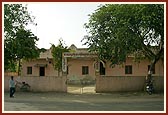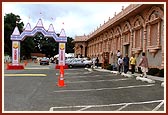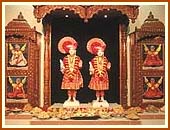| |
CE |
Day |
Event |
Vikram
Samvat |
Month |
Tithi |
| |
|
||
6 August || |
|
|
|
| 1821 |
Monday |
Vachanamrut Gadhada
II-6
Describing the nature of the chitt (mind), Shriji Maharaj says,
“The chitt of all people is like honey, or like water saturated
with gur, sugar or sakar. If, for example, a fly or an ant were
to fall into that honey or water saturated with gur, sugar or sakar,
it would become stuck in it. Even if a person were to touch the
honey or saturated water, it would stick to the person’s finger
as well. The nature of the chitt is similar to this; it sticks to
whatever object it recalls. In fact, the chitt even attaches itself
to things that are utterly insignificant, such as stones, or rubbish,
or dog excrement – things in which there is not even the slightest
pleasure. If it recalls such useless things, it will then also contemplate
upon them. Such is its sticky nature.”
|
1877 |
Shrãvan |
sud 8 |
| 1824 |
Friday |
Vachanamrut Gadhada
II-59
Shriji Maharaj reveals who gets an opportunity to serve God and
his Sadhu, “Only those who have accumulated a great number
of merits from performing good deeds receive the opportunity to
serve God’s Sant, but those who have a few merits do not.” |
1880 |
Shrãvan |
sud 12 |
| 1826 |
Sunday |
Vachanamrut Gadhada
III-4
Shriji Maharaj talks about the jiva, and how it pervades and animates
the body, “In the heart, there is a transformation of the
five mahabhuts into a disc of flesh, within which the jiva resides.
The jiva clings to this disc of flesh like a torch made of rags
that is set alight after being immersed in oil. Also, just as fire
pervades an iron nail, similarly, the jiva actually resides in the
disc of flesh, and by consciousness pervades the entire body. Therefore,
regardless of where pain is felt in the body, it is the jiva itself
that feels the pain; so, in fact, the jiva cannot be said to be
separate from the pleasures and pains of the body.” |
1882 |
Shrãvan |
sud 3 |
| 2001 |
Monday |
Murti-pratishtha
at Fresno, CA |
2057 |
Shrãvan |
vad 2 |
| |
|
|
|
|
|
| |
|
|
|
|
|
| |
|
||
7 August || |
|
|
|
| 1993 |
Saturday |
 Murti-pratishtha
at Chandkheda, Amdavad Murti-pratishtha
at Chandkheda, Amdavad
|
2049 |
Shrãvan |
vad 5 |
| |
|
|
|
|
|
| |
|
|
|
|
|
| |
|
||
8 August || |
|
|
|
| 1822 |
Thursday |
Vachanamrut Gadhada
II-25
Shriji Maharaj explains how worldly desires can be eradicated, “If
one becomes addicted to serving God and His Sant to the extent that
one would not be able to stay for even a moment without serving
them, then all of the impure desires in one’s antahkaran will
be destroyed.”
|
1878 |
Shrãvan |
vad 6 |
| 1991 |
Friday |
 Murti-pratishtha
at Edison, NJ Murti-pratishtha
at Edison, NJ |
2047 |
Ashãdh |
vad 14 |
| |
|
|
|
|
|
| |
|
|
|
|
|
| |
|
||
9 August || |
|
|
|
| 1821 |
Thursday |
Vachanamrut Gadhada
II-7
Elaborating on how one’s base nature may be overcome, even
if one lacks detachment, Shriji Maharaj says, “If a person
lacks vairagya, but intensely serves a great Sant, and obediently
perseveres in his observance of the injunctions of God, then God
will look upon him with an eye of compassion, and feel, ‘This
poor fellow lacks vairagya, and lust, anger, etc., are harassing
him very much. So now, may all those vicious natures be eradicated.’
As a result, they will be eradicated immediately. In comparison,
if he were to endeavour in other ways, those swabhavs may be eradicated,
but after a great deal of time and effort – either in this
life or in later lives. If such vicious natures are eradicated instantly,
then it should be known that they have been eradicated by the grace
of God.”
|
1877 |
Shrãvan |
sud 11 |
| 2002 |
Friday |
Murti-pratishtha
at Victor Ville |
2058 |
Shrãvan |
sud1 |
| 1999 |
Monday |
 Murti-pratishtha
at Durban, South Africa Murti-pratishtha
at Durban, South Africa |
2055 |
Ashãdh |
vad 13 |
| |
|
|
|
|
|
| |
|
|
|
|
|
| |
|
||
10 August || |
|
|
|
| 1821 |
Friday |
Vachanamrut Gadhada
II-8
Shriji Maharaj instructs all to observe the Ekadashi fast by narrating
the story of its origin, “One should observe the Ekadashi
fast because of the following story: Once, God was sleeping with
his ten indriyas and mind – the eleventh indriya – drawn
inwards. At that time, Mur Danav, the son of Nadijangh, came to
do battle with God. But then, a young woman was created from the
divine light of God’s eleven indriyas. Seeing her, Mur Danav
proposed to her, ‘Please marry me.’ The young woman
replied, ‘I have taken a vow that I will only marry the person
who defeats me in a duel.’ Thus, a duel between Mur Danav
and the young woman ensued, in which the young woman severed Mur
Danav’s head with a sword. God was pleased with her and said,
‘Ask for a boon.’ The young woman requested, ‘On
my day of observance, no one should eat grains. Furthermore, since
I was born from the divine light of your eleven indriyas, my name
is Ekadashi. Since I am an ascetic, on my day of observance, no
one should indulge in any of the vishays related to the eleven indriyas,
which includes the mind.’ Hearing Ekadashi’s wish, God
granted her that boon. This is the story as it is narrated in the
Purans.” |
1877 |
Shrãvan |
sud 12 |
| 1823 |
Sunday |
Vachanamrut Gadhada
II-31
Shriji Maharaj reveals that one can attain atma-realization by constantly
remembering God, “The jiva, however, has been associated with
the body, the indriyas and the vishays. As a result of this improper
association, the jiva has become one with the body, indriyas, etc.
After forsaking their association, the jiva realises, ‘My
self is Brahma, which is transcendental and free from maya.’
If one associates with Brahma through continuous contemplation in
this manner, the jiva acquires the virtues of that Brahma. However,
it is a great fault of the jiva that even after hearing this fact,
it cannot maintain constant remembrance.” |
1879 |
Shrãvan |
sud 4 |
| |
|
|
|
|
|
| |
|
|
|
|
|
| |
|
||
11 August || |
|
|
|
| 1823 |
Monday |
Vachanamrut Gadhada
II-32
The attachment to family is difficult to overcome. Shriji Maharaj
describes the nature of this bondage and shows how to transcend
it, “In worldly life, the affection one has for family members
is like that of a cactus plant or the branch of a banyan or pipal
tree. That is, if they are cut and transplanted elsewhere, they
would once again grow into trees. In comparison, once a mango tree
or a neem tree is cut, it does not take root again. The affection
that one has for those other than the members of one’s family
is like that of the mango tree or the neem tree. Again, the affection
one has for the members of one’s family is like the cactus
plant and banyan tree in that if they have been cut down, they unfailingly
do grow again, even while lying in the soil.
“For this reason, the affection that a person harbours for
his family is only uprooted when he realises his true form to be
the jivãtmã, distinct from the three bodies of sthul,
sukshma and kãran; when, discarding all vanity of gender,
caste and ashram, he beholds God’s form within it; and when
he becomes eager to engage only in the worship of God. Only then
will the affection that he harbours for his family be completely
cut. Besides this, though, there are no other means to do so.” |
1879 |
Shrãvan |
sud 5 |
| |
|
|
|
|
|
| |
|
|
|
|
|
| |
|
||
12 August || |
|
|
|
| 1821 |
Sunday |
 Vachanamrut
Gadhada II-9 Vachanamrut
Gadhada II-9
In the opening paragraph of this Vachanamrut, Shriji Maharaj is
described as wearing a surval, dagli, reto and shelu. Also, since
it is the day before Raksha Bandhan, he has rakhdis tied on his
wrist. [photos from Vach. Handbook]
|
1877 |
Shrãvan |
sud 14 |
| |
|
|
|
|
|
| |
|
|
|
|
|
| |
|
|
|
|
|
|
|




